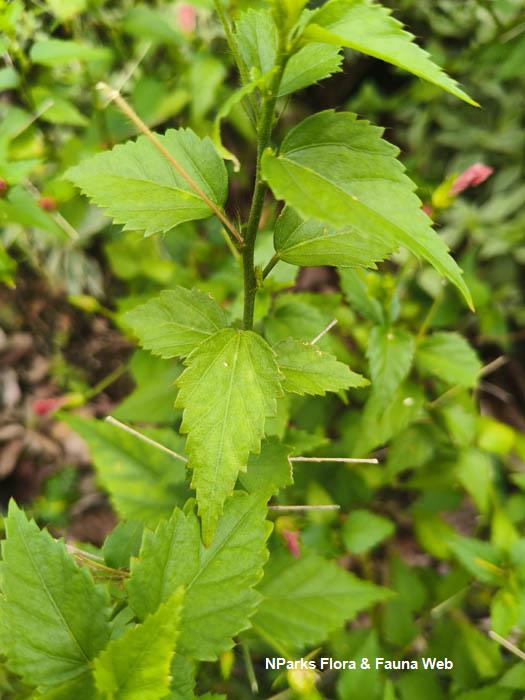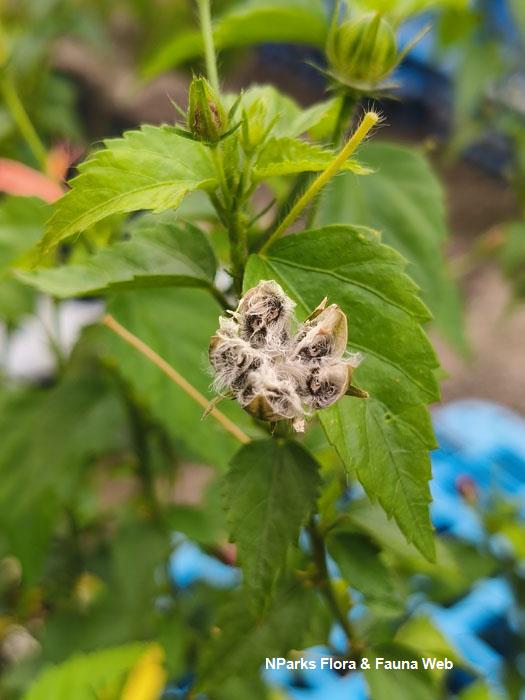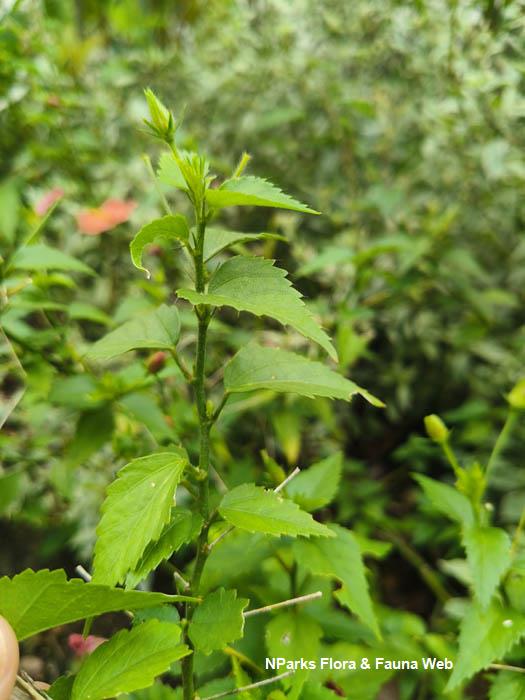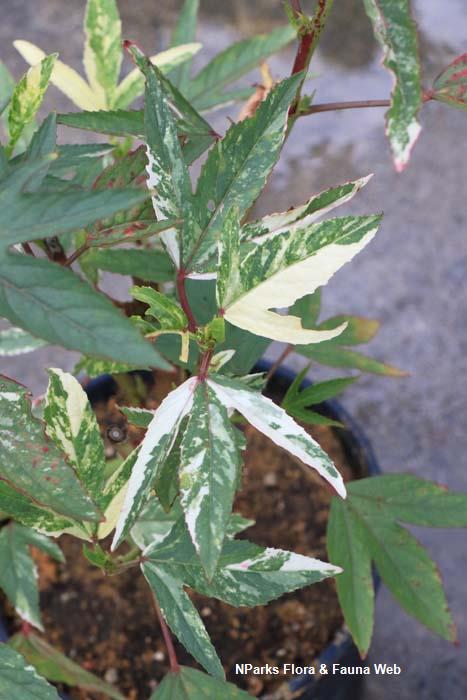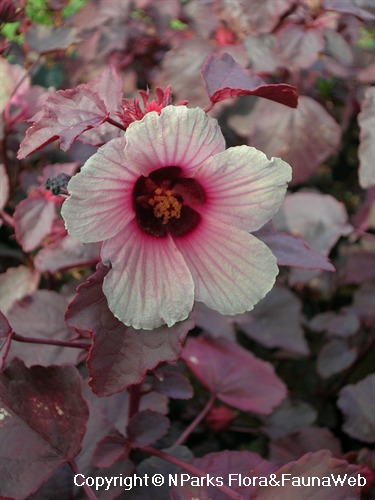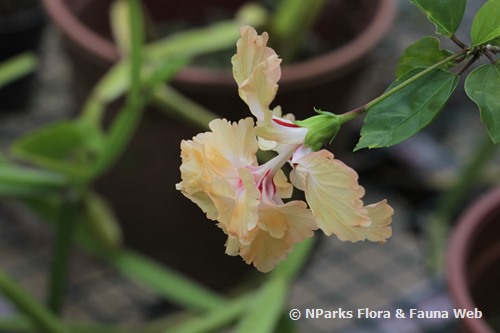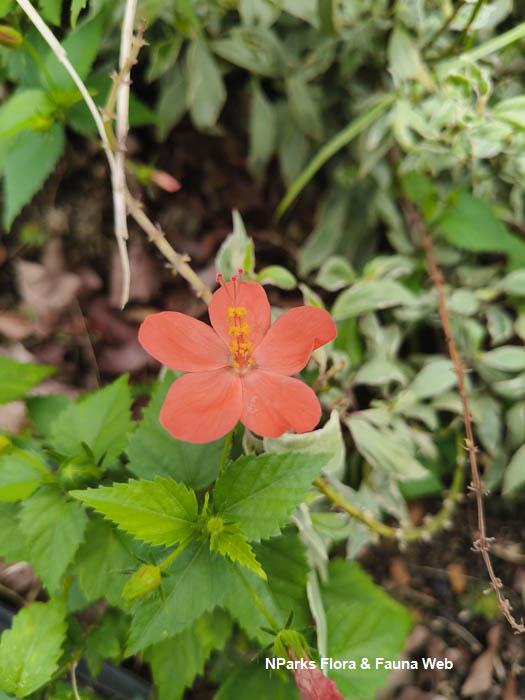
Back
Hibiscus sp.
| Family Name: | Malvaceae |
The Hibiscus species is a showy shrub suitable for growing as ornamental plant for its vibrant pink to brick-red trumpet-shaped flowers and egg-shaped leaves. The fruit splits open in 5 parts, releasing hairy seeds. This shrub grows up to 2 m tall and prefers full sun and moderate watering on well-drained soil.
Name
Classifications and Characteristics
| Plant Division | Angiosperms (Flowering Seed Plants) (Dicotyledon) |
|---|---|
| Plant Growth Form | Shrub |
| Lifespan (in Singapore) | Perennial |
| Mode of Nutrition | Autotrophic |
| Plant Shape | Irregular |
| Maximum Height | 2 m |
Biogeography
| Native Habitat | Terrestrial (Disturbed Area / Open Ground) |
|---|---|
| Preferred Climate Zone | Tropical |
| Local Conservation Status | Non-native (Horticultural / Cultivated Only) |
Description and Ethnobotany
| Growth Form | A shrub that grows up to 2 m tall. |
|---|---|
| Foliage | Leaves are egg-shaped (ovate), measuring 2 - 4 cm by 1.5 - 3 cm. Leaf base is rounded to slightly heart-shaped (cordate), leaf tip (apex) acute, toothed margin (serrate to dentate).The upper surface is sparsely hairy while lower surface is densely hairy. The petiole is 0.5 - 4 cm long with short hairs. Stipule is linear-shaped, 2 - 5 mm long and has hairs along the sides. |
| Stems | Stem is covered with very small (minute) hair. |
| Flowers | Flower is pink to brick-red, 2-3 cm in diameter, located along the stem. The flower petals are egg-shaped and arranged like in wheel-like on the flower stalk. The anthers are yellow, pink filaments are short (1 mm long) and glabrous. The style branches are pink and about 4-5 mm long, dark red stigmas are round and hairy. |
| Fruit | Capsule, ovoid to globose-shaped, measuring 7-10 mm in diameter. The outer surface is slightly hairy while the inner surface smooth. It has 5 locules, with each locule having 2-4 seeds. Seeds are kidney-shaped (reniform), measuring 3-3.5 mm long, greenish black and densely covered with long silky hair. |
Landscaping Features
| Landscaping | It has vibrant pink to red flowers which makes it a good addition to small gardens and parks. |
|---|---|
| Desirable Plant Features | Ornamental Flowers, Ornamental Foliage, Ornamental Fruits |
| Landscape Uses | General, Parks & Gardens, Small Gardens |
| Thematic Landscaping | Butterfly Garden |
Fauna, Pollination and Dispersal
| Fauna Pollination Dispersal Associated Fauna | Butterfly-Attracting (Flower Nectar) |
|---|---|
| Pollination Method(s) | Biotic (Fauna) (Insects (Butterfly, Moth), Insects (Bee)) |
| Seed or Spore Dispersal | Abiotic |
Plant Care and Propagation
| Light Preference | Full Sun |
|---|---|
| Water Preference | Moderate Water |
| Plant Growth Rate | Moderate |
| Rootzone Tolerance | Easy to Grow, Fertile Loamy Soils, Well-Drained Soils, Moist Soils |
| Propagation Method | Seed |
Foliar
| Foliage Retention | Evergreen |
|---|---|
| Mature Foliage Colour(s) | Green |
| Mature Foliage Texture(s) | Hairy / Hirsute |
| Prominent Young Flush Colour(s) | Green |
| Young Flush Texture(s) | Hairy / Hirsute |
| Foliar Modification | Stipule |
| Foliar Type | Simple / Unifoliate |
| Foliar Arrangement Along Stem | Alternate |
| Foliar Attachment to Stem | Petiolate |
| Foliar Shape(s) | Non-Palm Foliage (Ovate) |
| Foliar Venation | Pinnate / Net |
| Foliar Margin | Dentate, Serrate / Toothed |
| Foliar Apex - Tip | Acute |
| Foliar Base | Cordate, Rounded / Obtuse |
Non - Foliar and Storage
| Root Type | Underground |
|---|
Floral (Angiosperm)
| Flower & Plant Sexuality | Bisexual Flowers |
| Flower Colour(s) | Pink, Red |
|---|---|
| Flower Texture(s) | Smooth |
| Flower Grouping | Solitary |
| Flower Location | Axillary |
| Flower Symmetry | Radial |
| Individual Flower Shape | Trumpet-shaped |
| Flowering Period | Free-Flowering |
| Flowering Opening Time | Daytime |
Fruit, Seed and Spore
| Mature Fruit Colour(s) | Brown |
|---|---|
| Fruit Classification | Simple Fruit |
| Fruit Type | Dehiscent Dry Fruit , Capsule |
| Mature Seed Colour(s) | Black |
| Mature Seed Texture(s) | Velvety / Furry / Tomentose |
| Seed Quantity Per Fruit | Few (1-5) |
Image Repository
Others
| Master ID | 34535 |
|---|---|
| Species ID | 8948 |
| Flora Disclaimer | The information in this website has been compiled from reliable sources, such as reference works on medicinal plants. It is not a substitute for medical advice or treatment and NParks does not purport to provide any medical advice. Readers should always consult his/her physician before using or consuming a plant for medicinal purposes. |


